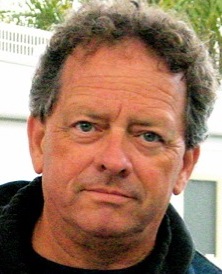View in web browser(Username: artist / March Password: manet)
Peggy's Progress
(Not to be confused with John Bunyan's tale of agony and doom!)

In 2000, Michael and I met through Match.com. After a couple of weeks of email exchanges our first face-to-face meeting was over dinner at a Thai restaurant, followed by him reading poetry to me (Mary Oliver no less) among the bookshelves at Bookshop Santa Cruz.
  We closed the night talking over coffee and dessert on the lovely brick patio behind the coffee place that has had too many different names to remember. It was during that encounter that he first asked me about my creative drive; what sparks me creatively and what is my creative energy? I had no answer. No one had ever asked me that before and frankly I'd never even thought about it before.
We closed the night talking over coffee and dessert on the lovely brick patio behind the coffee place that has had too many different names to remember. It was during that encounter that he first asked me about my creative drive; what sparks me creatively and what is my creative energy? I had no answer. No one had ever asked me that before and frankly I'd never even thought about it before.
No wonder I told my friend Geo, during the "debrief" following that first face-to-face meeting with Michael, that basically he seemed "nice but a bit intense." He would raise the question or some variation of it every now and then. And though he's caused me to think about it more, nearly 12 years and 10+ years of marriage later I still have no real answer to his question.
The fact that I'd never really thought about the question before probably has a lot to do with the fact that at the time I was a single, working mom with an 11 year old daughter. My brain was pretty much fried by a job I really enjoyed (for the most part) and whatever was left of any brain power and energy was focused on my daughter, the rest of my family, the house, the bills, the dogs, the cats, etc., etc. Who had time or energy to be creative?
And now I find myself in something of the same boat. I now go in to work every day and those days are full of all kinds of new challenges to my brain and creativity. You don’t want to see me trying to work with Adobe Photoshop and InDesign while on a deadline, it’s not a pretty sight. Thank goodness I have all those young techie mentors in the office, people literally half my age or less, to help me when I get stuck on something. I’ve discovered too that it’s harder for me to recover and bounce back from a really crazy long day or night at work. I’m clearly not as productive the day after, unlike the old days when I could pull an all-nighter or two in college without too much trouble. I had resigned myself to attribute this lack of resilience and alacrity to age.
So I was intrigued this week to come across some articles on NPR.org, and discovered what might actually be going on. Why is it that I resolve to do more art, to be more creative, but haven’t I gotten anywhere? Surely it’s not just a problem of time or lack thereof. Well, thanks to this interview of NPR reporter and neuroscience author, Jonah Lerher by Robert Krulwich and Jad Abumrad it would appear that I can honestly say I have "prefrontal cortex overload!" And, I am not alone.
"Why is it so hard to do the right thing? This time, you say to yourself, this time I will do 50 chin-ups every day or skip dessert or call my mother every Friday. It's time to do those things that I know, I really, really know I should do. And then you don't. According to British psychologist Richard Wiseman, 88 percent of all resolutions end in failure."
Wiseman’s 2007 University of Hertfordshire study included more than 3,000 people. So I’m in good company. And as Lehrer also notes:
"Knowing something is the right thing to do takes work — brain work — and our brains aren't always up to that."
Is it any wonder then that my New Years' resolutions to get creative and make some art haven’t produced much? I didn’t know how accurate I was last month when I likened the pursuit of creativity to be something like trying to diet. It all takes willpower.
Lehrer goes on to describe an experiment by Stanford University Professor Baba Shiv investigating the prefrontal cortex, located just behind the forehead. It's the part of our brain that is largely responsible for willpower. Shiv's experiment had two groups of subjects.
"One group was given a two-digit number to remember, while the second group was given a seven-digit number. Then they were told to walk down the hall, where they were presented with two different snack options: a slice of chocolate cake or a bowl of fruit salad.
"The students with seven digits to remember were nearly twice as likely to choose the cake as students given two digits. The reason, according to Professor Shiv, is that those extra numbers took up valuable space in the brain—they were a 'cognitive load'—making it that much harder to resist a decadent dessert. In other words, willpower is so weak, and the prefrontal cortex is so overtaxed, that all it takes is five extra bits of information before the brain starts to give in to temptation."
So there you have it, "prefrontal cortex overload". No wonder all I want is dinner when I come home from work. Although I take some consolation in the fact that Shiv's subjects were all Stanford undergraduates which is a good thing considering this other article by Jonah Lehrer in which he raised this cheery thought:
"The memory declines with age, maybe the imagination was the same way. This is kind of a depressing idea. There's nothing you can do to stop this dismal, downward trend. But now the thinking is there's nothing inevitable about this loss, which is why some creative people can maintain their imaginative output for their entire career. Instead, the decline of creativity is what psychologists refer to as 'inculturation.' That as we get older, as we get tenure in a field, we become invested in the status quo. We develop habitual ways of thinking, routines, we develop customs in terms of how we solve problems. Those make our lives a little bit easier, they make it easier to apply for grants. They make our days a little more efficient but they also make it harder to think outside the box."
  Thank goodness I kept reading further, otherwise I would have missed the part that it’s not just a factor of my age, I’m just "inculturated." But there's apparently a remedy for that condition and Jonah Lehrer has gone on to write a whole book about it: Imagine: How Creativity Works
Thank goodness I kept reading further, otherwise I would have missed the part that it’s not just a factor of my age, I’m just "inculturated." But there's apparently a remedy for that condition and Jonah Lehrer has gone on to write a whole book about it: Imagine: How Creativity Works . .
"What you should do then — when you hit the wall — is get away from your desk. Step away from the office. Take a long walk. Daydream. Find some way to relax. Get those alpha waves. Alpha waves are a signal in the brain that's closely correlated with states of relaxation. And what scientists have found is that when people are relaxed, they're much more likely to have those big 'A ha!' moments, those moments of insight where these seemingly impossible problems get solved. So when you hit the wall, the best thing you can do is probably take a very long, warm shower. The answer will only arrive once you stop looking for it."
This week I've come to the conclusion that maybe this is where I've gone off the path. Have I found the error of my ways? Perhaps I was approaching being creative too much like a New Years' resolution. So I diligently set a play date to make something and while that may have given me a sense of commitment and a target, in some ways it made those creative pursuits feel like just another bunch of tasks I should be doing. And when I'm tired after a busy day at the office or a long week, that darn "prefrontal cortex overload" kicks in and the willpower vanishes. The question of what's for dinner and what movie should we watch takes priority over making art. It's a bit of a double edged sword to give your creativity or your art a priority in your life. Your creativity needs to have a place of value along with your family and your work but then how do you keep it from becoming just like a job? Once it becomes more chore than delight, it's just another one of those "things you should do."
But maybe it’s just like sex. Don’t overanalyze it. Don’t overthink it. Don’t talk about it. Just do it!
Cross-Pollination
We'd like to take a moment here to tell you about one of our subscribers. His name is Jason Kelly, and he publishes a weekly subscription newsletter for investors called The Kelly Letter. Jason's newsletter has been going out to his subscribers for a long time. I'm not sure when it started, but I'm pretty sure it has been hitting the inbox for at least 7 years now. Jason and I got acquainted when we were both technical writers at IBM over a decade ago. We struck up a great and lasting friendship that has flourished despite distance and infrequent crossings of our paths. Jason has lived in Japan since around the time he began writing the Kelly Letter.
 He's an excellent writer, and brings a personal and human touch to the topic of investing and global finance like no one else I have ever read. This is because he is not your stereotypical investment guru. Jason is a creative, innovative guy with a big heart. I won't spend a lot of time here talking about this, but Jason set up an amazing project in the aftermath of the Fukushima incident last year called Socks for Japan. I encourage you all to look at what Jason and his international team of volunteers and contributors have accomplished. And the best reporting that I've seen about the ongoing situation in northeastern Japan comes from Jason's keyboard. You can read about that at Socks for Japan Reports on Jason's web site.
He's an excellent writer, and brings a personal and human touch to the topic of investing and global finance like no one else I have ever read. This is because he is not your stereotypical investment guru. Jason is a creative, innovative guy with a big heart. I won't spend a lot of time here talking about this, but Jason set up an amazing project in the aftermath of the Fukushima incident last year called Socks for Japan. I encourage you all to look at what Jason and his international team of volunteers and contributors have accomplished. And the best reporting that I've seen about the ongoing situation in northeastern Japan comes from Jason's keyboard. You can read about that at Socks for Japan Reports on Jason's web site.
 
  Jason's newsletter has more subscribers than we can even imagine at this point. He has been at it for a long time, and also has written The Neatest Little Guide series
Jason's newsletter has more subscribers than we can even imagine at this point. He has been at it for a long time, and also has written The Neatest Little Guide series of investing books published under the Plume imprint. His most recent books are
Financially Stupid People Are Everywhere: Don't Be One Of Them of investing books published under the Plume imprint. His most recent books are
Financially Stupid People Are Everywhere: Don't Be One Of Them , published by John T. Wiley, and
Stock Market Contest , published by John T. Wiley, and
Stock Market Contest , which is self published.
He also makes occasional appearances on radio, internet radio, and now and then, TV. , which is self published.
He also makes occasional appearances on radio, internet radio, and now and then, TV.
Now that you know a little about Jason, I have a confession to make. He has been our role model and one of our inspirations as we have launched Outside the Lines over the past few months. His audience is quite different from ours, but if you were to subscribe to The Kelly Letter, you would immediately notice some remarkable similarities. We use almost the same model for subscriptions, pricing, and structure for our business. We even use some of the same tools and services to make it all happen. In short, we picked his brain and copied much of what he is doing.
Recently we talked to Jason, and he offered to show Outside the Lines to his subscribers and his free list. But he asked me to write up a little thing about how I think what we do would be of interest to investment subscribers—something that he could use as a launch point to rewrite and expand for his readers. I love this challenge because it pushes me right out of the box. What would an investor, who studies charts, scours the news for hints about the stock market, and pours over financial reports, and loves doing it all, get out of reading about artists, musicians, writers, and what makes them tick?
I had to take a few days to think about this. The answer is rich, but not entirely obvious on the surface. The answer comes in two parts. For starters, no one is one-dimensional. The average investor is in the game for a reason other than the pure joy of analysis and risk/reward adventure that it provides. Yes, investors have to like the game to stay in it, but typically the bottom line is making money. And for most human beings, money is simply a tool for getting where you want to be with your life. The point I am making here, is that the typical investor is as atypical as you or me. They are all different. They want fulfillment and comfort and inspiration in their lives. Some investors are sports enthusiasts, or travelers, or engaged in a hobby or a philanthropic cause, but everyone seeks something that gives them a sense of fulfillment. And yes, some collect art. Some even make art themselves! I know this is true because for several years, I was in the market, and following The Kelly Letter myself. So part one of my answer to Jason's question is that we are all about fulfillment. People work, or invest, or whatever they do to make money, partly for survival, but everybody wants more than that. Everybody wants to seek their dreams. Everybody wants to step outside the lines and walk their own path.
We hinted at part two of my answer to Jason's question in last week's note. The topic was the book, Goal-Free Living: How to Have the Life You Want NOW! , by Stephen Shapiro. The final paragraph of that article bears repeating here. , by Stephen Shapiro. The final paragraph of that article bears repeating here.
 "Steve Jobs said that creativity is just a matter of having enough dots to connect. Dots, in this context are experiences and ideas. Unfortunately for goal oriented people, ideas come mostly from experiences, and experience comes from living in the present and keeping your agenda open. It does not come from detailed planning. It does not come from too much specialization and narrow expertise. It does not come from a singleminded focus. Plans, and the goals they are designed to meet, are good in small doses, but they are no substitute for the dynamics of living in the moment, with eyes wide open. Even if you are truly a goal person, you will benefit from stepping back, resetting your focus, and letting the stream carry you now and then."
"Steve Jobs said that creativity is just a matter of having enough dots to connect. Dots, in this context are experiences and ideas. Unfortunately for goal oriented people, ideas come mostly from experiences, and experience comes from living in the present and keeping your agenda open. It does not come from detailed planning. It does not come from too much specialization and narrow expertise. It does not come from a singleminded focus. Plans, and the goals they are designed to meet, are good in small doses, but they are no substitute for the dynamics of living in the moment, with eyes wide open. Even if you are truly a goal person, you will benefit from stepping back, resetting your focus, and letting the stream carry you now and then."
The worst thing you can do if you want to be innovative, resourceful, and a leader in your field is to be too narrow in your focus. The most innovative breakthroughs, in any area of endeavor, come when you relax and forget about the stress of getting it right. Shapiro says that expertise is the arch enemy of innovation.
And borrowing from one of the NPR articles that Peggy referred to in her piece today, Jonah Lerher talks about the importance that Steve Jobs placed on cross-pollination between people in different disciplines. Lehrer talks at length about how Jobs redesigned the Pixar studios from three buildings in
 which the various disciplines, computer programmers, cartoonists, and support staff were isolated by discipline, into one huge space where everyone rubbed elbows. He even went so far as to insist that there be only two large central restrooms in the whole building, one for each gender, because he knew that everyone would go there every day.
which the various disciplines, computer programmers, cartoonists, and support staff were isolated by discipline, into one huge space where everyone rubbed elbows. He even went so far as to insist that there be only two large central restrooms in the whole building, one for each gender, because he knew that everyone would go there every day.
"... He wanted there to be mixing. He knew that the human friction makes sparks, and that when you're talking about a creative endeavor that requires people from different cultures to come together, you have to force them to mix; that our natural tendency is to stay isolated, to talk to people who are just like us, who speak our private languages, who understand our problems. But that's a big mistake. And so his design was to force people to come together even if it was just going to be in the bathroom."
Experts come too quickly to answers based on their training and experience and the conventional wisdom in their field, meaning that an innovation could be right under their nose and go unseen. Shapiro gives the example of a potato chip company that solved a difficult problem not by going to the lab with their potato chip gurus, but by listening to a musician who knew nothing about potato chip technology, but had noticed something interesting when he put a bowl of chips on top of a very loud speaker.
I am not suggesting that an investor should abandon the charts and the fundamentals. I'm definitely not suggesting that an investor should come to us for market advice! But I am suggesting that investors, like everybody else, would do well to take a walk in the sunshine. Go to a baseball game. Visit an art gallery. Go out of your way to get acquainted with people in different walks of life—people you wouldn't ordinarily connect with. Push out the boundaries and spend some energy on what really inspires you. In other words, get outside the lines! These are things that I know that Jason frequently encourages his subscribers to do. And they're good advice for all of us!
So in conclusion, I guess my answer to Jason, and his subscribers, would be that what we do here at Outside the Lines is cross-pollination. It's a good way to explore your own fulfillment and to keep your thinking fresh and edgy. We're not just another art rag. We are here to support creativity in all its forms.
|




 He's an excellent writer, and brings a personal and human touch to the topic of investing and global finance like no one else I have ever read. This is because he is not your stereotypical investment guru. Jason is a creative, innovative guy with a big heart. I won't spend a lot of time here talking about this, but Jason set up an amazing project in the aftermath of the Fukushima incident last year called
He's an excellent writer, and brings a personal and human touch to the topic of investing and global finance like no one else I have ever read. This is because he is not your stereotypical investment guru. Jason is a creative, innovative guy with a big heart. I won't spend a lot of time here talking about this, but Jason set up an amazing project in the aftermath of the Fukushima incident last year called 

 "Steve Jobs said that creativity is just a matter of having enough dots to connect. Dots, in this context are experiences and ideas. Unfortunately for goal oriented people, ideas come mostly from experiences, and experience comes from living in the present and keeping your agenda open. It does not come from detailed planning. It does not come from too much specialization and narrow expertise. It does not come from a singleminded focus. Plans, and the goals they are designed to meet, are good in small doses, but they are no substitute for the dynamics of living in the moment, with eyes wide open. Even if you are truly a goal person, you will benefit from stepping back, resetting your focus, and letting the stream carry you now and then."
"Steve Jobs said that creativity is just a matter of having enough dots to connect. Dots, in this context are experiences and ideas. Unfortunately for goal oriented people, ideas come mostly from experiences, and experience comes from living in the present and keeping your agenda open. It does not come from detailed planning. It does not come from too much specialization and narrow expertise. It does not come from a singleminded focus. Plans, and the goals they are designed to meet, are good in small doses, but they are no substitute for the dynamics of living in the moment, with eyes wide open. Even if you are truly a goal person, you will benefit from stepping back, resetting your focus, and letting the stream carry you now and then."
 which the various disciplines, computer programmers, cartoonists, and support staff were isolated by discipline, into one huge space where everyone rubbed elbows. He even went so far as to insist that there be only two large central restrooms in the whole building, one for each gender, because he knew that everyone would go there every day.
which the various disciplines, computer programmers, cartoonists, and support staff were isolated by discipline, into one huge space where everyone rubbed elbows. He even went so far as to insist that there be only two large central restrooms in the whole building, one for each gender, because he knew that everyone would go there every day.